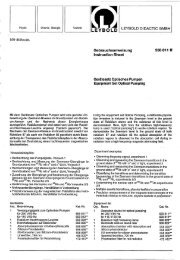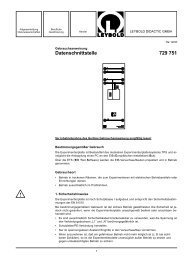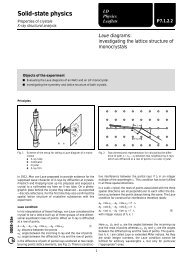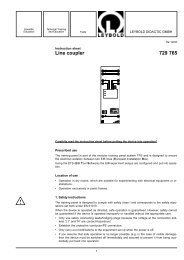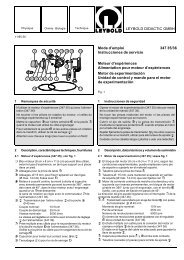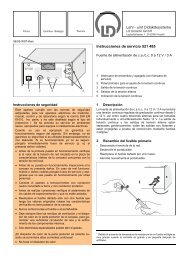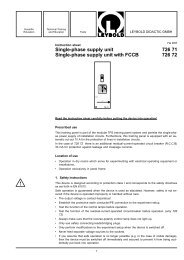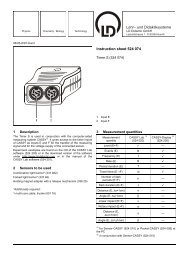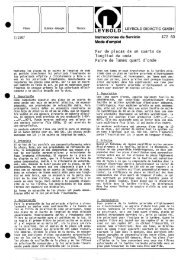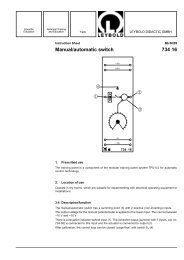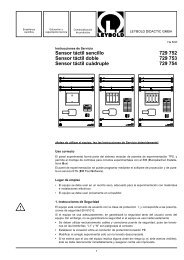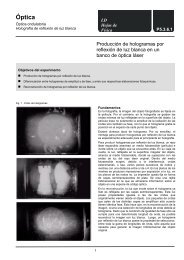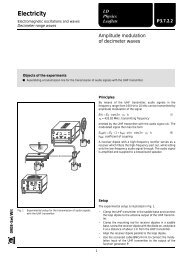LEYBOLD DIDACTIC GMBH Gebrauchsanweisung 666 432 ...
LEYBOLD DIDACTIC GMBH Gebrauchsanweisung 666 432 ...
LEYBOLD DIDACTIC GMBH Gebrauchsanweisung 666 432 ...
Erfolgreiche ePaper selbst erstellen
Machen Sie aus Ihren PDF Publikationen ein blätterbares Flipbook mit unserer einzigartigen Google optimierten e-Paper Software.
8/96-Mue-<br />
Physik Chemie ⋅ Biologie Technik <strong>LEYBOLD</strong> <strong>DIDACTIC</strong> <strong>GMBH</strong><br />
Bei der Verbrennung fossiler Brennstoffe wie Kohle und Erdöl<br />
entsteht Schwefeldioxid. Durch Auswaschung des Schwefeldioxids<br />
mit Regenwasser bildet sich schweflige Säure die gesundheits-<br />
und umweltschädigend (z.B. saurer Regen) wirkt.<br />
Durch die Verbrennung von Kohle oder Erdöl in Industrieanlagen<br />
wird Schwefeldioxid gebildet, welches durch Entschwefelung<br />
gereinigt werden muß.<br />
Man bedient sich in der Technik dem nassen " Kalkstein-Verfahren"<br />
oder Kalkwaschverfahren.<br />
1 Sicherheitshinweise<br />
Unbedingt unter dem Abzug arbeiten! Das giftige<br />
Schwefeldioxid nicht einatmen!<br />
Schliffe an den Glasgeräten vorschriftsmäßig fetten<br />
und Schliffe mit Schliffklemmen sichern!<br />
Gummi-Glas-Verbindungen mit Glycerol gleitend<br />
machen!<br />
Lange Haare gegen Verbrennen schützen!<br />
Calciumoxid wirkt reizend!<br />
- Stäube nicht einatmen!<br />
- Kontakt mit der Haut vermeiden!<br />
Schutzbrille und Schutzhandschuhe tragen!<br />
2 Beschreibung (Fig. 1)<br />
� Grundplatte mit Bohrungen für Halter und Pictogramm<br />
�� Halter für Verbrennungstiegel<br />
�� Trichter mit gewinkeltem Glasrohr<br />
�� Halter für Trichter<br />
�� Glasverbinder mit 2 GL-18 Verschraubungen<br />
�� Waschflasche<br />
�� Halter für Waschflasche<br />
Zunächst wird der Halter für den Verbrennungstiegel � mittels<br />
zweier Schrauben auf die Grundplatte � geschraubt. Danach<br />
schraubt man an die Metallstange die kleine Ferderklemme und<br />
verbindet die so vorbereitete Halterung � mittels einer Schraube<br />
mit der Grundplatte. Die Halterungen für die Waschflasche �<br />
<strong>Gebrauchsanweisung</strong> <strong>666</strong> <strong>432</strong><br />
Instruction Sheet<br />
CPS-Gassammler<br />
CPS-Gas Collector<br />
Fig. 1<br />
CPS-Gassammler<br />
CPS-gas collector<br />
The combustion of fossil fuels such as coal and petroleum produces<br />
sulphur dioxide. When sulphur dioxide is washed out of<br />
the atmosphere by rain sulfuric acid is formed, which represents<br />
a significant hazard to both health and the environment<br />
(e.g. acid rain).<br />
The sulphur dioxide produced in industrial plants through the<br />
burning of coal or petroleum must be removed by desulfurization.<br />
In industrial-scale applications, the wet "limestone process" or<br />
lime scrubbing process is used.<br />
1 Safety notes<br />
Conduct all work under a fume hood! Do not breath<br />
the poisonous sulphur dioxide!<br />
Grease all ground joints on glassware properly and<br />
secure ground joints using joint clips!<br />
Lubricate all rubber-glass connections using glycerine.<br />
Protect long hair from fire!<br />
Calcium oxide is an irritant:<br />
- Do not inhale calcium oxide dust!<br />
- Avoid contact with the skin!<br />
Always wear protective goggles and gloves.<br />
2 Description (Fig. 1)<br />
� Base, with holes for holder and schematic diagram<br />
�� Holder for combustion crucible<br />
�� Funnel with angled glass tube<br />
�� Holder for funnel<br />
�� Glass connector with 2 GL-18 screw connections<br />
�� Wash bottle<br />
�� Holder for wash bottle<br />
First screw the holder for the combustion crucible � to the base<br />
� using two screws. Then screw the small spring clip to the<br />
metal rod and attach the holder assembled in this manner � to<br />
the base using a screw. The holder for the wash bottle � is<br />
assembled by inserting the long screw through the plastic clip,
wird zusammengebaut, indem man durch die Plastikklemme<br />
die lange Schraube hindurchsteckt, die graue Plastikhülse über<br />
das Gewinde der Schraube schiebt und mittels der Mutter mit<br />
der Grundplatte verbindet. Die zweite Halterung setzt man entsprechend<br />
zusammen. Nun wird die Waschflasche � in die<br />
Halterung gesteckt und mittels je eines Gummiringes fixiert.<br />
Den Glasverbinder � mit der Waschflasche verbinden, indem<br />
man zunächst die Plastikschraubkappe der GL-18 Verschraubung<br />
über den mit dem langen Glasrohr der Waschflasche versehenen<br />
Glasanschluß schiebt und anschließend die Silikondichtung<br />
auf den Glasanschluß steckt und in die Schraubkappe<br />
drückt. Nun läßt sich der Glasverbinder anschrauben. Der<br />
Trichter mit dem Winkelrohr � wird an der Metallklemme befestigt<br />
und die GL-18 Verschraubung entsprechend, wie bei der<br />
Waschflasche beschrieben, aufgesetzt. Durch das Hoch- oder<br />
Herunterschieben der Waschflasche kann die Höhe beider<br />
Glasgeräte auf der Platte so austarriert werden, daß der Glasverbinder<br />
zwischengeschraubt werden kann (siehe Fig. 1).<br />
3 Versuchsdurchführung -<br />
Rauchgasentschwefelung<br />
Zusätzlich erforderliche Geräte und Chemikalien<br />
1 Profilrahmen C 100 <strong>666</strong> 428<br />
1 CPS-Gaswäscher <strong>666</strong> 430<br />
1 CPS-Woulff’sche Flasche <strong>666</strong> 438<br />
1 CPS-Schlauchbefestigung <strong>666</strong> 449<br />
2 CPS-Glasverbinder 667 312<br />
3 CPS-Blindplatten (300 mm) <strong>666</strong> 468<br />
1 Vakuumschlauch 667 186<br />
1 Wasserstrahlpumpe 375 56<br />
2 Porzellantiegel 664 002<br />
1 Deckel für Porzellantiegel 664 008<br />
1 Löffelspatel <strong>666</strong> 963<br />
1 Pinzette 667 026<br />
1 Tiegelzange 667 035<br />
1 Meßpipette, 5 ml 665 996<br />
1 Meßzylinder, 100 ml 665 754<br />
1 Bunsenbrenner, Allgas 656 016<br />
1 elektronische Waage 667 795<br />
Schwefel subl. 674 761<br />
Glycerin (Glycerol, Propantriol) 672 121<br />
dest. Wasser 675 340<br />
Universalindikator (flüssig) 675 255<br />
pH-Universal-Indikatorpapier 661 070<br />
Calciumcarbonat 671 231<br />
Calciumoxid 671 321<br />
Schliff-Fett 661 082<br />
Fig 2<br />
Aufbau der Versuchsdurchführung zur Rauchgasentschwefelung (mit CPS-Modulen)<br />
Experiment assembly for fume-gas desulfurization (with CPS modules)<br />
2<br />
sliding the gray plastic sleeve over the thread of the screw and<br />
attaching this assembly to the base using a nut. Assemble the<br />
second holder in the same way. Now place the wash bottle � in<br />
the holder and secure it with one rubber ring each. Connect the<br />
glass connector � to the wash bottle: first slide the plastic<br />
screw cap of the GL-18 screw connection over the glass connection<br />
fitting of the wash bottle with the long glass tube, place<br />
the silicone gasket on the glass connection fitting and press it<br />
into the screw cap. You can now screw on the glass connector.<br />
Mount the funnel with the angle tube � in the metal clip and<br />
attach the GL-18 screw connection as described for the wash<br />
bottle. By moving the wash bottle up and down, you can equalize<br />
the height of the two glass components so that the glass<br />
connector can be screwed in between them (see Fig. 1).<br />
3 Experiment procedure - desulfurizing fume<br />
gases<br />
Additionally required apparatus and chemicals<br />
1 Panel frame C 100 <strong>666</strong> 428<br />
1 CPS-gas washer <strong>666</strong> 430<br />
1 CPS-Woulff’s bottle with manometer <strong>666</strong> 438<br />
1 CPS-hose fastener <strong>666</strong> 449<br />
2 CPS-glass connectors 667 312<br />
3 CPS-blank panels (300 mm) <strong>666</strong> 468<br />
1 Vacuum tubing 667 186<br />
1 Water jet pump 375 56<br />
2 Porcelain crucible 664 002<br />
1 Cover for porcelain crucible 664 008<br />
1 Spatula with spoon end <strong>666</strong> 963<br />
1 Tweezers 667 026<br />
1 Crucible tongs 667 035<br />
1 Measuring pipette, 5 ml 665 996<br />
1 Graduated cylinder, 100 ml 665 754<br />
1 Bunsen burner, universal 656 016<br />
1 Electronic precision balance 667 795<br />
Sulphur subl. 674 761<br />
Glycerine 672 121<br />
Distilled water 675 340<br />
Universal indicator (liquid) 675 255<br />
pH-indicator paper 661 070<br />
Calcium carbonate 671 231<br />
Calcium oxide 671 321<br />
Stopcock grease 661 082
� 1 Profilrahmen C 100 <strong>666</strong> 428<br />
�� 1 Porzellantiegel 664 002<br />
�� 1 CPS-Gassammler <strong>666</strong> <strong>432</strong><br />
�� 1 CPS Gaswäscher <strong>666</strong> 430<br />
�� 2 CPS-Glasverbinder 667 312<br />
�� 1 CPS Woulff’sche Flasche <strong>666</strong> 438<br />
�� 1 CPS Schlauchbefestigung <strong>666</strong> 449<br />
�� 1 Vakuumschlauch 667 186<br />
�� 1 CPS-Blindplatte (100 mm) <strong>666</strong> 464<br />
In die obere Zeile des Profilrahmens C 100 (<strong>666</strong> 428) werden<br />
nacheinander die CPS-Module Gassammler (<strong>666</strong> <strong>432</strong>), Gaswäscher<br />
(<strong>666</strong> 430), Woulff’sche Flasche (<strong>666</strong> 438) und<br />
Schlauchbefestigung (<strong>666</strong> 449) eingesetzt. (In diesem Versuchsaufbau<br />
ist die Waschflasche des Gassammlers (<strong>666</strong> <strong>432</strong>)<br />
als Sicherheitsflasche zu schalten!) Mittels zweier Glasverbinder<br />
(667 312) verbindet man die Module über GL-18 Verschraubungen<br />
luftdicht miteinander. Dazu werden die Plastik-<br />
Schraubkappen über die Glasansätze der Waschflaschen geschoben<br />
und danach die Silikondichtungen aufgesteckt und in<br />
die Plastikschraubkappe eingedrückt. Nun läßt sich der Glasverbinder<br />
an die Schraubkappe anschrauben und mit dem<br />
nachfolgenden Modul verbinden. Auf das Ableitungsrohr der<br />
Woulff’schen Flasche (<strong>666</strong> 438) (langes Winkelrohr) schiebt<br />
man den Vakuumschlauch und befestigt ihn an der Schlauchbefestigung<br />
(<strong>666</strong> 449). Die Woulff’sche Flasche dient in diesem<br />
Aufbau als Sicherheitsflasche. Die an der Wasserleitung angebrachte<br />
Wasserstrahlpumpe (375 56) wird mit dem Vakuumschlauch<br />
(667 186) verbunden.<br />
Unter den Trichter des CPS-Gassammlers (<strong>666</strong> <strong>432</strong>) stellt man<br />
einen mit 1 g sublimiertem Schwefel (674 761) befüllten Porzellantiegel<br />
(664 002), in welchem der Schwefel entzündet worden<br />
ist. Durch Einschalten der Wasserstrahlpumpe wird das entstehende<br />
Schwefeldioxid durch die nachfolgenden Gaswaschflaschen<br />
gezogen. Der Sog der Wasserstrahlpumpe ist so einzustellen,<br />
daß das entstehende Gas kontinuierlich durch die Apparatur<br />
strömt. Dabei wird die erste Gaswaschflasche am Gassammler<br />
ebenfalls, wie die Woulff’sche Flasche, als Sicherheitsflasche<br />
geschaltet. In die erste Gaswaschflasche darf keine<br />
Flüssigkeit eingefüllt werden. Zum Nachweis des entstehenden<br />
Schwefeldioxids klebt man in die erste Waschflasche einen<br />
Streifen angefeuchtetes Universal-Indikatorpapier (661 070). In<br />
die erste Waschflasche des CPS-Moduls Gaswäscher<br />
(<strong>666</strong> 430) füllt man eine wäßrige Suspension von 1 g Calciumoxid<br />
(671 321) in 100 ml dest. Wasser (675 340), die mit einigen<br />
Tropfen Universalindikator versehen worden sind. In die<br />
zweite Waschflasche des CPS-Moduls Gaswäscher gibt man<br />
100 ml dest. Wasser und ebenfalls einige Tropfen Universalindikator.<br />
Alle noch freien Stellen des Profilrahmens werden mit<br />
den Blindplatten (<strong>666</strong> 464 und <strong>666</strong> 468) ausgefüllt.<br />
Sobald der Indikator des Kalkwassers einen Farbumschlag<br />
zeigt - Neutralisation - kann die Flamme des brennenden<br />
Schwefels gelöscht werden (indem man den Porzellantiegel<br />
abdeckt) und die Wasserstrahlpumpe wird abgestellt.<br />
Das pH-Universal-Indikatorpapier in der ersten Waschflasche<br />
zeigt eine Rotfärbung und somit den Nachweis des Enstehens<br />
einer Säure. In der zweiten Waschflasche neutralisiert die entstehende<br />
schweflige Säure das Calciumhydroxid und es bildet<br />
sich Calciumhydrogensulfit.<br />
Die Farbe in der dritten Waschflasche ändert sich nicht, da alles<br />
Schwefeldioxid in der zweiten Waschflasche durch Neutralisation<br />
und Bildung von Hydrogensulfit gebunden worden ist.<br />
Leitet man nun Luftsauerstoff über das Hydrogensulfit, indem<br />
die Wasserstrahlpumpe erneut angestellt wird, kommt es zur<br />
Oxidation des Hydrogensulfits und man erhält Calciumsulfat<br />
(Gips), dessen Bildung durch deutliche Trübung erkannt werden<br />
kann.<br />
2 H2SO3 + CaO ⎯→ Ca(HSO3)2 + H2O<br />
Ca(HSO3)2 + CaO + 3 H2O + O2 ⎯→ 2 CaSO4 ⋅ 2 H2O<br />
� 1 Panel frame C 100 <strong>666</strong> 428<br />
�� Porcelain crucible 664 002<br />
�� 1 CPS-gas collector <strong>666</strong> <strong>432</strong><br />
�� 1 CPS-gas washer <strong>666</strong> 430<br />
�� 2 CPS-glass connectors 667 312<br />
�� 1 CPS Woulff’s bottle with manometer <strong>666</strong> 438<br />
�� 1 CPS-hose fastener <strong>666</strong> 449<br />
�� 1 Vacuum tubing 667 186<br />
�� 1 CPS-blank panel (100 mm) <strong>666</strong> 464<br />
One after another, place the CPS-modules gas collector<br />
(<strong>666</strong> <strong>432</strong>), gas washer (<strong>666</strong> 430), Woulff’s bottle with manometer<br />
(<strong>666</strong> 438) and CPS-hose fastener (<strong>666</strong> 449) in the top level<br />
of the panel frame C 100 (<strong>666</strong> 428). (In this experiment setup<br />
the wash bottle of the gas collector (<strong>666</strong> <strong>432</strong>) must be connected<br />
as a safety bottle!) Connect the modules air-tight using GL-<br />
18 screw connections of the two glass connectors (667 312).<br />
For this purpose, slide the plastic screw caps over the glass<br />
connection fittings of the wash bottles, and then slide on the<br />
silicone gaskets and press them into the plastic screw cap. The<br />
glass connector can now be screwed to the screw caps and<br />
connected with the next module. Slide the vacuum tubing onto<br />
the outlet tube of the Woulff’s bottle (<strong>666</strong> 438) (long angle tube)<br />
and secure it in the hose fastener (<strong>666</strong> 449). In this experiment,<br />
the Woulff’s bottle with manometer serves as a safety bottle.<br />
Set up the water jet pump (375 56) on the water supply line and<br />
connect it to the vacuum tubing (667 186).<br />
Place a porcelain crucible (664 002) filled with 1 g sublimated<br />
sulphur (<strong>666</strong> <strong>432</strong>) which has been ignited beneath the funnel of<br />
the CPS-gas collector. When the water jet pump is switched on,<br />
the resulting sulphur dioxide is drawn through the following gas<br />
wash bottles. Adjust the suction of the water jet pump so that<br />
the gas generated flows continuously through the apparatus.<br />
The first gas wash bottle of the gas collector is connected as a<br />
safety bottle, just like the Woulff’s bottle with manometer. Do<br />
not fill any liquid into the first gas wash bottle. To demonstrate<br />
that sulphur dioxide is generated, attach a strip of moistened<br />
pH-indicator paper (661 070) inside the first wash bottle. Fill the<br />
first wash bottle of the CPS-module gas washer (<strong>666</strong> 430) with<br />
an aqueous suspension of 1 g calcium oxide (671 321) in<br />
100 ml distilled water (675 340), to which a few drops of the<br />
universal indicator has been added. In the second wash bottle<br />
of the CPS-module gas washer, add 100 ml distilled water and<br />
a few drops of the universal indicator as well. Fill in all open<br />
spaces in the panel frame using blank panels (<strong>666</strong> 464 and<br />
<strong>666</strong> 468).<br />
As soon as the indicator for the lime water changes color - neutralization<br />
- you can extinguish the flame of the burning sulphur<br />
(by covering the porcelain crucible) and switch off the water jet<br />
pump.<br />
The pH-indicator paper in the first wash bottle is red, indicating<br />
that an acid has been formed. In the second wash bottle, the<br />
resulting sulfuric acid neutralizes the calcium hydroxide, leading<br />
to the formation of calcium hydrogen sulfite.<br />
The indicator in the third wash bottle does not change color, as<br />
all the sulphur dioxide has been bound in the second wash bottle<br />
through neutralization and the formation of hydrogen sulfite.<br />
If we now channel atmospheric oxygen to the hydrogen sulfite<br />
by switching the water jet pump back on, the hydrogen sulfite<br />
oxidizes and produces calcium sulfate (gypsum); this process<br />
is clearly recognizable by a significant increase in turbidity.<br />
2 H2SO3 + CaO ⎯→ Ca(HSO3)2 + H2O<br />
Ca(HSO3)2 + CaO + 3 H2O + O2 ⎯→ 2 CaSO4 ⋅ 2 H2O<br />
<strong>LEYBOLD</strong> <strong>DIDACTIC</strong> <strong>GMBH</strong> ⋅ Leyboldstrasse 1 ⋅ D-50354 Hürth ⋅ Phone (02233) 604-0 ⋅ Telefax (02233) 604-222 ⋅ Telex 17 223 332 LHPCGN D<br />
© by Leybold Didactic GmbH, Printed in the Federal Republic of Germany<br />
Technical alterations reserved



